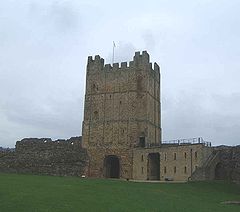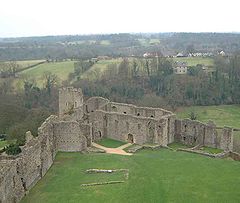
Richmond Castle
Encyclopedia


Richmond, North Yorkshire
Richmond is a market town and civil parish on the River Swale in North Yorkshire, England and is the administrative centre of the district of Richmondshire. It is situated on the edge of the Yorkshire Dales National Park, and serves as the Park's main tourist centre...
, North Yorkshire
North Yorkshire
North Yorkshire is a non-metropolitan or shire county located in the Yorkshire and the Humber region of England, and a ceremonial county primarily in that region but partly in North East England. Created in 1974 by the Local Government Act 1972 it covers an area of , making it the largest...
, England
England
England is a country that is part of the United Kingdom. It shares land borders with Scotland to the north and Wales to the west; the Irish Sea is to the north west, the Celtic Sea to the south west, with the North Sea to the east and the English Channel to the south separating it from continental...
, stands in a commanding position above the River Swale
River Swale
The River Swale is a river in Yorkshire, England and a major tributary of the River Ure, which itself becomes the River Ouse, emptying into the North Sea via the Humber Estuary....
, close to the centre of the town of Richmond
Richmond, North Yorkshire
Richmond is a market town and civil parish on the River Swale in North Yorkshire, England and is the administrative centre of the district of Richmondshire. It is situated on the edge of the Yorkshire Dales National Park, and serves as the Park's main tourist centre...
. It was originally called Riche Mount, 'the strong hill'. The castle was constructed from 1071 onwards as part of the Norman Conquest of Saxon England as the Domesday Book of 1086 refers to 'a castlery' at Richmond in that year.
William the Conqueror had put down the 1069 rebellion at York which was followed by his "harrying of the North" - an act of ethnic cleansing which depopulated large areas for a generation or more. As a further punishment he divided up the lands of north Yorkshire among his most loyal followers. Alain Le Roux de Ponthievre of Brittany
Brittany
Brittany is a cultural and administrative region in the north-west of France. Previously a kingdom and then a duchy, Brittany was united to the Kingdom of France in 1532 as a province. Brittany has also been referred to as Less, Lesser or Little Britain...
received the borough
Borough
A borough is an administrative division in various countries. In principle, the term borough designates a self-governing township although, in practice, official use of the term varies widely....
of Richmond and began constructing the castle to defend against further rebellions and establish a personal power base for one of the most extensive Norman estates in England which covered parts of eight counties - the Honour of Richmond. The Dukes of Brittany became the owners of the castle though it was often confiscated for various periods by English Kings.
The original stone Norman castle appears to have lacked an obvious final refuge or 'keep' but a 100 feet (30.5 m)-high keep of honey-coloured sandstone was constructed at the end of the 12th century by Duke Conan the Little. This keep was probably completed by King Henry II
Henry II of England
Henry II ruled as King of England , Count of Anjou, Count of Maine, Duke of Normandy, Duke of Aquitaine, Duke of Gascony, Count of Nantes, Lord of Ireland and, at various times, controlled parts of Wales, Scotland and western France. Henry, the great-grandson of William the Conqueror, was the...
and had 11 feet (3.4 m)-thick walls. Modern visitors can climb to the top of the keep for magnificent views of the town of Richmond. At the same time that the keep was probably completed, Henry II considerably strengthened the castle by adding towers and a barbican
Barbican
A barbican, from medieval Latin barbecana, signifying the "outer fortification of a city or castle," with cognates in the Romance languages A barbican, from medieval Latin barbecana, signifying the "outer fortification of a city or castle," with cognates in the Romance languages A barbican, from...
. Henry III and King Edward I spent more money on the site including Edward's improvements to the keep interior.
In addition to the main circuit of the wall, there was the barbican in front of the main gate which functioned as an 'air lock' - allowing visitors and wagons to be checked before entry to the main castle. On the other side of the castle overlooking the river was another enclosure or bailey called the Cockpit which may have functioned as a garden and was overlooked by a balcony. A drawing of 1674 suggests there was another longer balcony overlooking the river side of Scolland's Hall, the Great Hall.
As a castle Richmond had fallen out of use by the end of the 14th century and did not receive major improvements after that date. A survey of 1538 shows it was ruinous but paintings by Turner and others and the rise of tourism and an interest in antiquities led to repairs to the keep in the early 19th century.
The castle became the headquarters of the North Yorkshire Militia in 1855, with a military barracks
Barracks
Barracks are specialised buildings for permanent military accommodation; the word may apply to separate housing blocks or to complete complexes. Their main object is to separate soldiers from the civilian population and reinforce discipline, training and esprit de corps. They were sometimes called...
constructed in the great courtyard. The barracks were the home of Boy Scouts founder Robert Baden-Powell for two years until 1910 while he commanded the Northern Territorial Army but the barracks building was eventually demolished in 1931.
The castle was used during the First World War as the base of the Non-Combatant Corps made up of conscientious objectors - conscripts who refused to fight. It was also used to imprison some conscientious objectors who refused to accept army discipline and participate in the war in any way. These included 'the Richmond 16' who were taken to France from the castle, charged under Field Regulations and then sentenced to death, these death sentences then being commuted to ten years' hard labour.
As presented today Richmond Castle has one of the finest examples of Norman buildings in Britain including Scollands Hall, the Great Hall of the castle. The keep has a restored roof and floors but is shown with the original 11th century main gate arch unblocked. This arch is now in the basement of the later 12th century keep which was built in front of it, the main gate then being moved to its present position which was dominated by the adjacent keep while the original arch we see today was filled-in to secure the keep.
Today the castle is in the care of English Heritage
English Heritage
English Heritage . is an executive non-departmental public body of the British Government sponsored by the Department for Culture, Media and Sport...
which publishes a guidebook written by John Goodall PhD FSA.

